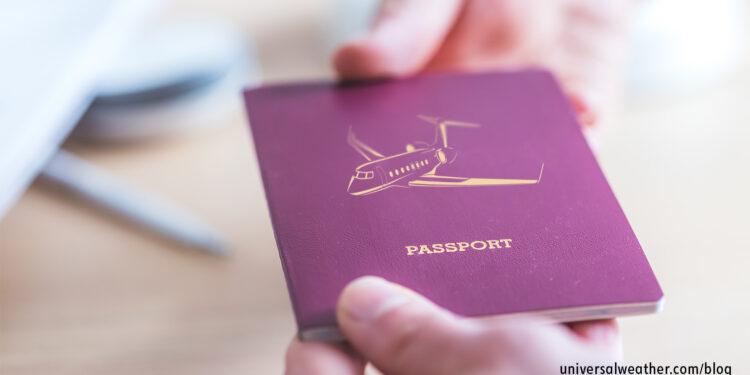U.S. Customs for Non-U.S. Registered Charter Aircraft (Active Trip): Clearing U.S. Customs

This business aviation blog post is part of a series on U.S. Customs for Non-U.S. Registered Charter Aircraft and continues from our previous post.
For charter (non-scheduled commercial) aircraft operators, clearing U.S. customs involves additional documentation, procedures and lead times than it does for private non-revenue operators. Additional considerations come into play when operating a non-U.S. registered charter aircraft. Always have an acceptable customs bond in place along with a carrier ID number and updated master crew list. Working with an experienced 3rd-party provider helps ensure that U.S. customs clearance is an uneventful experience.
Here are some key things you need to know about clearing U.S. customs:
1. What nationalities require visas to enter the U.S.?
Non-U.S. flight crews operating commercial aircraft require C1D visas per U.S. regulations. Passenger visa requirements depend upon nationality and type of business to be conducted. A Canadian national, for example, may enter the U.S. without a visa for tourism, but requires a visa for business purposes. If you’re an approved signatory carrier under the Visa Waiver Program (VWP), qualifying passengers (nationals of 36 countries) may obtain an Electronic System for Travel Authorization (ESTA) and don’t require visas.
2. Is there a difference between an I-94 and an ESTA?
I-94 is an entry form for non-U.S. nationals with visas. I-94Ws are no longer being produced and have been replaced by ESTA for passengers who qualify under the VWP. Crew should always confirm pre-flight that qualifying foreign nationals have ESTA confirmation numbers. Only operators approved as VWP signatory carriers may arrive with foreign nationals without visas. Non-U.S. passengers arriving to the U.S. with an approved ESTA but traveling on a non-signatory carrier are in violation of U.S. Customs law and can be penalized, which includes possible deportation.
3. What should an operator know about the location they’ll clear customs at?
Always contact your airport of arrival beforehand to ensure that you have all required information and documentation. Be aware of customs hours of operation, lead time for customs notification, maximum size of aircraft – or passenger count – permitted to clear, and agriculture requirements.
4. What’s the process to clear U.S. customs?
Proceed to the customs ramp or designated Fixed Based Operator (FBO) for customs clearance and do not open the door until customs gives the go-ahead. It’s the responsibility of the crew to know where to clear customs. If customs is not there on arrival, contact the local office, or after hours, call the Customs Communication Center at 1-800-X-SECTOR. Depending upon the location and officer on duty, it may be possible to clear on the aircraft. Alternatively, you might have to deplane and offload all the luggage. After clearance, you may leave the airport or depart with your aircraft if you are making a tech stop. In some cases, when operating a larger aircraft or with more than 10-15 passengers on board, you may need to clear at a gate and not the customs ramp. This depends on the airport, so check requirements in advance.
5. Are there special considerations when operating diplomatic flights?
If you’re operating a diplomatic flight, as opposed to a regular flight with diplomats onboard, you will notify the State Department and be provided with a diplomatic- clearance number. The State Department forwards this information to customs. Your 3rd-party provider should also contact customs, provide your diplomatic clearance number, and advise of any delays or updates to ETA.
6. What does an operator need when arriving from south of the 30th parallel?
You must land at a designated Airport of Entry (AOE) on the border region when arriving from the south, unless you have a BOE. A list of designated airports is in CBP’s Private Flyer’s Guide. Without a BOE, you’ll need to stop at a specific airport, and you cannot overfly one designated border AOE for another. For example, overlying Florida to land at Brownsville, TX (KBRO) is not permitted. One-shot and annual BOEs can be obtained if adequate notice and information is provided, and filing requirements are the same for private non-revenue or charter (non-scheduled commercial) flights.
7. Is a customs bond required for all charter (non-scheduled commercial) operations into the U.S?
Yes, this bond is necessary for all charter aircraft arrivals and departures. It’s recommended that the bond be for $100,000 USD as there are many airports of entry that do not accept customs bonds below this amount. Customs will deny you entry if they deem the amount of the bond insufficient. The Los Angeles area, for example, requires a $100,000 USD bond. Be aware that it can take months to obtain a customs bond via a customs broker who’ll arrange the bond through a surety company. Bonds may be obtained for single entry or for 1-2 year terms. At some airports of entry, you may be able to use a 3rd-party bond, but at many locations, including south Florida, such bonds are not accepted.
Conclusion
The process of clearing U.S. customs varies somewhat from airport to airport in terms of where you’ll clear and procedural nuances. When clearing at a new location, it’s always best practice to check local requirements in advance with customs or via your 3rd-party provider. Always re-confirm that you have all required visas, customs bonds and permits (e.g. BOE or TSA waivers) to avoid operational delays and/or penalties.
Questions?
If you have any questions about this article, contact me at adamhartley@univ-wea.com.




